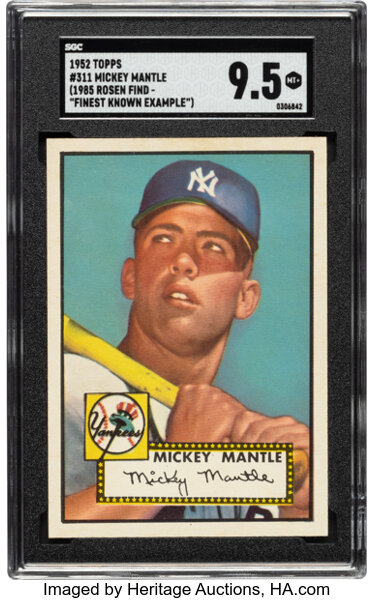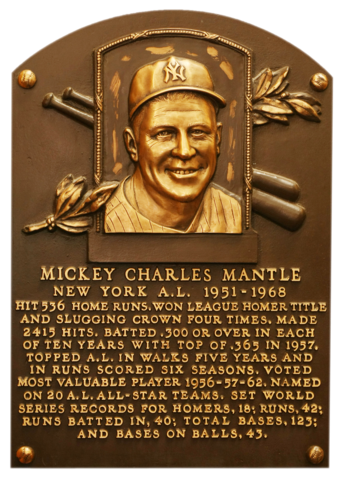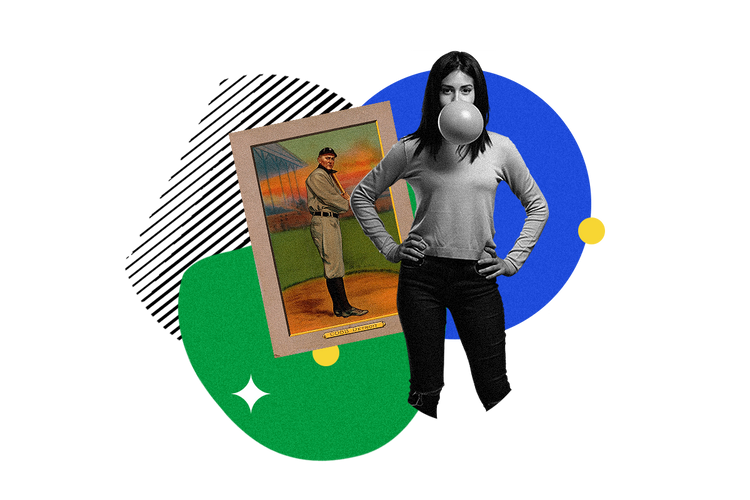Is Investing in Mickey Mantle Baseball Cards a Home Run?
Mickey Mantle baseball cards are some of the most sought-after and valuable collectible sports cards out there, but are they good investments?

Collecting baseball cards can be a lot of fun: hunting down rare copies of your favorite players, speculating which card is the next must-have, and creating the perfect shrine to display your prized pieces. But collecting sports cards is more than a hobby. They can be considered viable alternative investments like wine, concert tickets, and luxury watches.
Consider the crown jewel of collectible baseball cards: the 1952 Topps Mickey Mantle baseball card. This coveted card has captivated collectors for years—a natural baseball diamond. One of these sold for $12.6 million in August 2022, knocking the existing record—$6.6 million for a T206 Honus Wagner card—out of the park.
“If the nostalgic explosion had happened in the 2000s instead of the 1980s, the Topps 1952 card might be just another card.”
Long before card owner Anthony Giordano listed it on Heritage Auctions, it was purchased in 1991 for $50,000—equal to $108,765 in 2022. But how did a scrap of cardboard pull a 115× return in a bear market?

Topps Mickey Mantle baseball card that sold for $12.6 million.
Source: ha.com
Part of the answer is that sports cards might be a better store of value than they seem, bringing in overall positive returns during the last three market crashes.

Chart comparing PWCC 2500 and SPX from 2017 to 2022,
source: MoneyMade
But the 1952 Mickey Mantle rookie card isn’t just any sports card. The mythical reputation of the Mick’s iconic card involves a bold designer, a borrowed trash barge, and the mission to sell bubble gum year-round. Let’s take a closer look at the story of the rare Mantle rookie card.
Why is Mickey Mantle so famous?
Mickey “Muscles” Mantle was a talented and beloved athlete who spent his career as a center fielder for the New York Yankees from 1951 to 1968. Mantle won the Triple Crown in 1956, became known for his impressive power at bat, and was inducted into the Baseball Hall of Fame in 1974.
| Mickey Mantle’s career statistics and highlights: | |
| Number of seasons for the Yankees | 18 |
| Batting average | 0.298 |
| Hits | 2,415 |
| Home runs | 536 |
| RBIs | 1,676 |
| Gold Glove Awards | 1 |
| World Series wins | 7 |

Mantle’s Baseball Hall of Fame plaque.
Source: baseballhall.org
He wasn’t just a great player, though. His going, going, gone slugging power was impressive enough to make him MVP three times during his career, but that wasn’t the reason every Yankees fan hoped for his card in their pack of gum.
The thing you have to understand about baseball cards is that, while they had been around since the mid-1800s, they didn’t become valuable for years. The first price catalog for sports cards wasn’t even published until 1979. Kids weren’t collecting the cards for their high resale value, they just wanted their favorite players.
And with 20 All-Star Games under his belt and a personality that drew in the fans, the Mick was everyone’s favorite player.
He was the kid that should never have played—and almost didn’t. Mantle was one of the fastest players ever to run from home to first base, but serious injuries meant he could hardly run at all. He solved that problem by hitting the balls out of the park instead.
Mantle wasn’t the best player. He was great, but not the greatest. But he made the best of what he had and he won the hearts of fans. It was the Golden Age of Baseball, when games were airing in color on TV for the first time. What would become a classic New York City show at Yankee Stadium was also a perfect opportunity for Mantle to take the world by storm.
And that wasn’t the only time he was in the right place at the right time. Fast forward to the late 1980s and early 1990s and, suddenly, baseball cards are highly valuable. Not the contemporary cards, but ones rich in nostalgia became viable investment assets. Collectors wanted the Mick.
Why is the 1952 Mickey Mantle baseball card so valuable?
A 1914 Babe Ruth card, one of just a handful in existence, sold for at least $6 million in 2021. The buyer has not made the sales price public, but they are offering shares at $3 a piece on Collectable. It’s hard to imagine a baseball collectible being more valuable than a piece of the Great Bambino’s history, but there are a few factors influencing the rare Mickey Mantle rookie card value.
Hey, rookie!
The rookie might be the guy who gets pushed around on the field, but when it comes to their cards, they’re the instant MVP. Our baseball card study found that 72% of the top 200 cards on PWCC Marketplace are rookie cards.
The Mick is special in this regard, though. The prized 1952 Topps card is not technically his rookie card. Mantle’s career with the Yankees started in 1951, but he spent a year away from New York—in Kansas City.
Playing for the Yankees’ farm team, the Mick was in an 0–22 slump that nearly sent him back home to Oklahoma before the season ended. But when his father showed up to take him home to a life of working in mines, Mantle’s slump broke. He finished the season batting 0.360 and returned to the New York Yankees.

1951 Bowman #253 Baseball Card.
Source: baseballalmanac.com
The official Mickey Mantle rookie card is the 1951 Bowman #253, not the Topps card from 1952. But this technicality hasn’t affected the Topps card’s value. The Bowman 1951 rookie card has sold for up to $500,000 in 2022—impressive, but a far cry from $12 million.
Right place, right time (again)
If the nostalgic explosion had happened in the 2000s instead of the 1980s, the Topps 1952 card might be just another card. Valuable, but fetching a final price of $12.6 million? Probably not.
But it was the late 80s. The US had won the Cold War, and decades of high inflation had finally been crushed down. The stock market was just starting what we recognize as one of the greatest 50-year periods in history for investors. And fans who grew up in the latter years of Baseball’s Golden Age were in their financial prime.
For those who grew up in the 50s and had plenty of money to revisit their childhood thirty years later, Mantle was their guy. And the Topps 1952 card was the Holy Grail.
Topps Chewing Gum, Inc. printed its first cards that year. To make a splash in the crowded market, Topps made their cards bigger, more colorful, and all-around higher quality than anything that had come before them. However, even being highly sought-after and well-designed, the 1952 Mantle card is hard to find in top condition.
Sleeping with the fishes
In order to keep customers purchasing gum and cards all season long, Topps released each year’s cards in four series. Each series had fewer copies printed. That made the fourth series, with cards #311 through #407, the rarest of the bunch. The Mick’s popularity placed his card in this bundle at #311.
Unfortunately, even with a smaller number of cards and popular players to collect, the fourth series had to compete with football season. It didn’t stand a chance.
Topps executive vice-president and card designer Sy Berger tried for years to sell the leftover stock of fourth-series 1952 cards, even dropping the price to 10 for a penny. Finally, he decided to clear space in the warehouse by dumping the stock—literally—he dumped the 300 to 500 remaining boxes of 1952 Topps, including Mantle’s and Jackie Robinson’s cards, off a friend’s trash barge and into the Atlantic Ocean.
As a result, not many 1952 cards are still around. There are only 1,574 graded by the Professional Sports Authenticator (PSA). Of those, three are top-rated Gem Mint quality, outranking the $12.6 million card (it was graded 9.5 by PSA).

A box that survived the 1960 clear-out.
Source: forbes.com
What is a Mickey Mantle baseball card worth?
The PSA places the 1952 Topps #311 Mantle card value between $25,000 and $4.25 million, depending on the grade of the card. However, as the August 2022 sale shows, it could be worth much more to a motivated collector.
And even if you can’t get your hands on #311, the record sale price may increase the value of other Mantle cards. Current events tend to generate more interest in collectibles.
One example is a ticket to Michael Jordan’s first game in the NBA, which sold for a record-breaking $468,000 in 2022, just months after a stub to the same game sold for $264,000.
With the news of the impressive sale and the rarity of 1952 Mantle cards—thanks to litterbug Sy Berger—even those looking worse for wear might go up in value.
For instance, the T206 Honus Wagner card has become the yardstick for measuring the quality of a sports card. Generally, the better preserved a collectible card is, the higher its grade on the PSA scale. But several low-grade T206 Honus Wagner cards have sold for hundreds of thousands of dollars—even over a million. With enough demand, collectors are willing to pay for sports cards that are rough around the edges.

How to invest in a Mickey Mantle baseball card
While there’s always a chance that you’ll stumble across a Gem Mint 1952 Topps Mantle card while snorkeling off the Jersey Shore, you’ll probably have more luck purchasing one instead.
Browsing sports auctions on sites like Heritage Auctions, the PWCC Marketplace, or even eBay might pay off. A lower-graded card could still result in a modest ROI as the excitement of the record-smashing sale continues. If buying sports cards outright is too rich for your blood, consider fractionalized marketplaces like Percent, Rally, and Collectable. You can purchase shares of assets like sports cards, cars, and other collectibles.
You shouldn’t grab every card with a 1 grade and try to flip them for eight figures. But if you can afford to pick up a decently priced card, keep an eye out for good opportunities to sell. Attending gatherings like the National Sports Collectors Convention—last attended by 60,000 like-minded sports collectors in Atlantic City—can help you get a sense of the collectibles market and could perhaps be a chance to hit a home run on your next baseball card investment.
